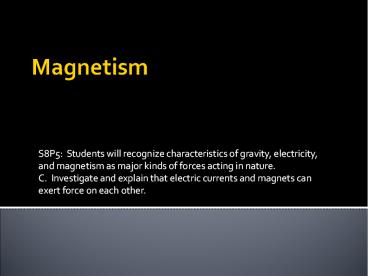Magnetism PowerPoint PPT Presentation
Title: Magnetism
1
Magnetism
- S8P5 Students will recognize characteristics of
gravity, electricity, and magnetism as major
kinds of forces acting in nature. - C. Investigate and explain that electric
currents and magnets can exert force on each
other.
2
What is Magnetism?
- When you think of magnets, you might think about
the objects that hold notes to your refrigerator.
But magnets can also be found in many other
everyday items such as wallets, kitchen cabinets,
and security tags at a store. - A magnet is any material that attracts iron and
materials that contain iron.
3
Properties of Magnets
- Many years ago, people discovered an unusual kind
of rock. This rock contained a mineral called
magnetite. Rocks containing magnetite attracted
minerals that contained iron. They also
attracted or repelled other magnetic rocks. This
attraction or repulsion of magnetic materials is
called magnetism.
4
Properties of Magnets
- About a thousand years ago, people discovered
another property of magnetic rocks. If they
allowed the rock to swing freely from a string,
one part of the rock would always point in the
same direction (toward the North Star, Polaris).
This star is also called the leading star, or
lodestar. For this reason, magnetic rocks are
known as lodestones.
5
Properties of Magnets
- Magnets have the same properties as magnetic
rocks. - Magnets attract iron and materials that contain
iron. - Magnets attract or repel other magnets.
- One part of the magnet will always point north
when allowed to swing freely.
6
Magnetic Poles
- Magnets in your everyday life have the same
properties as magnetic rocks because they are
made to have them. - Any magnet, no matter what its shape, has two
ends, each one called a magnetic pole. - The magnetic effect of a magnet is strongest at
the poles. - A magnet always has a pair of poles, a north pole
and a south pole.
7
Magnetic Interactions
- What happens if you bring two magnets together?
- Magnetic poles that are unlike attract each
other, and magnetic poles that are alike repel
each other. - If you put the north pole of one magnet near the
south pole of another magnet, the two unlike
poles attract one another. - If you put the north pole of one magnet near the
north pole of another magnet, the to like poles
will move away from each other. The same is true
if you bring two south poles together.
8
Magnetic Force
- The attraction or repulsion between magnetic
poles is magnetic force. - A force is a push or pull that can cause an
object to move. - A magnetic force is produced when magnetic poles
interact. - Any material that exerts a magnetic force is
considered to be a magnet.
9
Magnetic Fields
- A magnetic force is strongest at the poles of a
magnet, but it is not limited to the poles. - Magnetic forces are exerted all around a magnet.
- The area of magnetic force around a magnet is
known as its magnetic field. - Because of magnetic fields, magnets can interact
without even touching.
10
Magnetic Fields
- Magnetic field lines are invisible lines that map
out the magnetic field around a magnet. - Magnetic field lines spread out from one pole,
curve around the magnet, and return to the other
pole. - The lines form complete loops form pole to pole
and never cross. Arrows are used to indicate the
direction of the magnetic field lines, always
leaving the north pole and entering the south
pole. - The distance between magnetic field lines
indicates the strength of a magnetic field. The
closer the lines are, the stronger the field. A
magnets magnetic field lines are closest
together at the poles.
11
Magnetic Fields
- Although you cannot see a magnetic field, you can
see its effects with iron filings. - The magnetic forces of the magnet act on the iron
filings and align them along the invisible
magnetic field lines. - There can be a single magnetic field or combined
magnetic fields depending on how many magnets
there are and if those magnets overlap.

